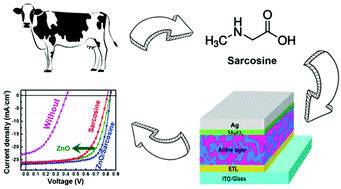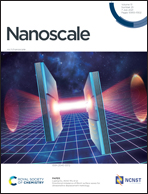Natural biomaterial sarcosine as an interfacial layer enables inverted organic solar cells to exhibit over 16.4% efficiency†
Abstract
The natural biomaterial sarcosine as an electron transport layer (ETL) to modify ITO or ITO/ZnO was successfully introduced into inverted organic solar cells (OSCs) with PM6:BTP-BO-4Cl as the active layer. The introduction of sarcosine on the surface of ITO or ITO/ZnO resulted in lower work function (WF) and higher surface energy. The active layers processed on the surfaces of ITO or ITO/ZnO presented a more optimized morphology and a more ordered molecular arrangement after their modification with sarcosine. The introduction of sarcosine as an ETL promoted charge transport and collection in the OSCs. Therefore, the power conversion efficiency (PCE) of the OSCs increased to 13.53% from 3.86% by modifying ITO with sarcosine. The PCE of the OSCs with ZnO as ETLs improved to 16.45% from 14.85% by modifying ZnO with sarcosine. The improved PCEs benefited from the simultaneously improved short-circuit current density (JSC), fill factor (FF), and open-circuit voltage (VOC). Therefore, this work demonstrates that sarcosine has great potential as an ETL to improve the performance of OSCs.



 Please wait while we load your content...
Please wait while we load your content...